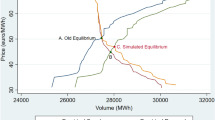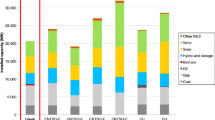Abstract
This paper studies and forecasts the evolution of concentration of Greek energy market, expressed by market shares of operators. The evolution of liberalization process of the Greek electricity market is dynamically estimated based on concepts of population biology, according to specific data for providers’ market shares. Using the Lotka–Volterra model and Integral method to determine the unknown parameters, the methodology of prey-predator model is applied to describe the competition among Greek alternative electricity providers, towards obtaining a larger market share from the common source of electrical energy of current dominant provider and future adopters. The proposed model managed to validate the available statistical data for the examined case study and is proven to be suitable for forecasting market concentration and equilibrium in electricity area. The evaluation reveals that the market share of the incumbent operator is expected to remain quite high by the year 2020 and this is why the application of a cropping strategy is proposed in order to reduce its share to 50% complied with European directions and ensure smooth coexistence of the two interacting species. The described methodology can become a powerful managerial tool for decision-makers and providers in order to drive performance and price competitiveness.

source: EURELECTRIC Innovation Action Plan Task Force Analysis)













Similar content being viewed by others
Data Availability
Not applicable.
Code Availability
Not applicable.
References
Joskow PL (2008) Lessons learned from the electricity market liberalization. Massachusetts Institute of Technology, Center for Energy and Environmental Policy Research
Conti F (2013) EURELECTRIC’s Innovation Action Plan: shaping the prospects of future energy technologies. EURELECTRIC ANNUAL CONVENTION & CONFERENCE, Bologna
Pool N (2017) History of Nord Pool Organization. Nord Pool
School HK (2011) Replacing the pool in the UK: justification for and effects of the new electricity trading arrangements, International Conference, Cartagena
Green R (2010) Are the British electricity trading and transmission arrangements future-proof? Utilities Policy 18:186–194
Jamasb T, Pollitt M (2005) Electricity market reform in the European Union: review of progress toward liberalization & integration. Energy J 11–41
Kammenakis E (2017) Electricity liberalization, pricing policies and value-added services of electricity providers in Europe. TEI of Crete
Parliament E (2009a) Directive 2009/72/ΕC, 14/08/2009 ed. European Parliament, pp. 55–93
Parliament E (2009b) Regulation 713/2009/ΕC, 14/08/2009 ed. European Parliament, pp. 1–14
Government G (1999) Law 2773/1999 "Liberalization of the electricity market - Regulation of energy policy issues and other provisions", Government Gazette A 286 / 22.12.1999. Greek Government Gazette
Government G (2005) Law 3426/2005 "Accelerating the procedure for the liberalization of the electricity market", Government Gazette A 309 / 22.12.2005. Greek Government Gazette
LAGΙE (2015) Monthly penetration report for wholesale and retail electricity market, Greek Electricity Market Officer
Fiorio CV, Florio M (2013) Electricity prices and public ownership: evidence from the EU15 over thirty years. Energy Economics 39:222–232
Saving TR (1970) Concentration ratios and the degree of monopoly. Int Econ Rev 11:139–146
El Khatib S, Galiana FD (2019) Investigating emission regulation policy in the electricity sector: modeling an oligopolistic electricity market under hourly cap-and-trade. Energy Economics 78:428–443
Fehr NHMRVD, Harbord D (1993) Spot market competition in the UK electricity industry. Econ J 103:531–546
Green RJ, Newbery DM (1992) Competition in the British electricity spot market. J Polit Econ 100:929–953
Newbery DM (1998) Competition, contracts, and entry in the electricity spot market. RAND J Econ 726–749
Glachant J-M, Finon D (2003) Competition in European electricity markets. Edward Elgar publishing
Haas R, Glachant J-M, Keseric N, Perez Y (2006) Competition in the continental European electricity market: despair or work in progress? Electricity market reform: an international perspective, 265–315
Neal D (2018) Introduction to population biology. Cambridge University Press
Kloppers P, Greeff J (2013) Lotka-Volterra model parameter estimation using experiential data. Appl Math Comput 224:817–825
Michalakelis C, Christodoulos C, Varoutas D, Sphicopoulos T (2012) Dynamic estimation of markets exhibiting a prey–predator behavior. Expert Syst Appl 39:7690–7700
Lee S-G, Yu M, Yang C, Kim C (2011) A model for analyzing churn effect in saturated markets. Ind Manag Data Syst 111:1024–1038
Parliament E (2009c) Regulation (EC) No 714/2009, 14/08/2009 ed, pp. 15–35
Streimikiene D, Bruneckiene J, Cibinskiene A (2013) The review of electricity market liberalization impacts on electricity prices. Transform Bus Econ 12:40–60
Rademaekers KSM, Yearwood J, Saheb Y, Moerenhout J, Pollier K, Debrosses N, Badouard T, Peffen A, Pollitt H, Heald S, Altman M (2018) Study on energy prices, costs and subsidies and their impact on industry and households. Trinomics B.V., Rotterdam, The Netherlands
EUROSTAT ESE (2016) Energy price statistics. Eurostat Luxemburg
Explained ES (2016) Electricity production, Consumption and Market Overview
EUROSTAT (2017) “Electricity market indicators for period 2003–2015”, February 2017 ed. Eurostat
Heddenhausen M (2007) Privatisations in Europe’s liberalised electricity markets–the cases of the United Kingdom, Sweden, Germany, and France. Stiftung Wissenschaft und Politik, Research Unit EU Integration http://swpberlin.org/fileadmin/contents/products/projekt_papiere/Electricity_paper_KS_IIformatiert.pdf (Letöltés dátuma 2016. 03. 29)
Government G (2015) Law 4336/2015 "Pension Rules - Ratification of the Draft Financial Contribution Agreement by the European Stability Mechanism and arrangements for the implementation of the financing agreement", Greek Government Gazette A 94/14–8–2015. Greek Government Gazette
LAGΙE (2016) Auction System of long-term electric power products, Conference on Auction Transactions System of Electricity Products. Greek Electricity Market Officer Athens, Greece
Government G (2016a) Law 4389/2016 "Pension Provisions - Ratification of the Draft Financial Contribution Contract by the European Stability Mechanism and arrangements for the implementation of the financing agreement", Greek Government Gazette A 94 / 27–5–2016. Greek Government Gazette
Government G (2016c) Ministry Decision 35–20/05/2016 "Adoption of an Auction Application Plan (NOME)", Greek Government Gazette B 1473/25.05.2016. Greek Government Gazette
Government G (2016d) Ministry Decision 38–06/06/2016, "Adoption of an Auction Application Plan (NOME)", Greek Government Gazette Β 1593/06.06.2016. Greek Government Gazette
Government G (2017) Law 4472/2017, "Article 101, Amendment of the provisions of Law 4389/2016 (Α94) on the Electricity Market", Greek Government Gazette A 74/19.05.2017. Greek Government Gazette
Government G (2016b) Law 4425/2016 "The stock exchange wholesale electricity market", Greek Government Gazette A 185/30.09.2016.18. Greek Government Gazette, (2016). Law 4425/2016 "The stock exchange wholesale electricity market", Greek Government Gazette A 185/30.09.2016. Greek Government Gazette
Paraskevopoulos-Kolias C (2016) The structure of the Greek electricity market
Polemis ML, Dagoumas AS (2013) The electricity consumption and economic growth nexus: evidence from Greece. Energy Policy 62:798–808
RΑΕ (2018) The background of electricity in Greece. Regulatory Authority of Energy in Greece
LAGΙE (2018b) Monthly penetration report for wholesale and retail electricity market
LAGΙE (2018a) DAS Monthly Report of March 2018
COMMISSION E (2015) GREECE: memorandum of understanding for a three-year ESM programme
Michalakelis C, Sphicopoulos T, Varoutas D (2011) Modeling competition in the telecommunications market based on concepts of population Biology. IEEE Transactions on Systems, Man, and Cybernetics. Part C (Applications and Reviews) 41:200–210
Kacelnik A, Krebs JR, Bernstein C (1992) The ideal free distribution and predator-prey populations. Trends Ecol Evol 7:50–55
Jones DS, Plank M, Sleeman BD (2009) Differential equations and mathematical biology. Chapman and Hall/CRC
Murray JD (1989) Mathematical biology, vol. 19 of Biomathematics. Springer, Berlin, Germany
Paul S, Mondal SP, Bhattacharya P (2016) Numerical solution of Lotka Volterra prey predator model by using Runge–Kutta–Fehlberg method and Laplace Adomian decomposition method. Alex Eng J 55:613–617
Mitropoulou P, Filiopoulou E, Michalakelis C, Nikolaidou M (2016) Pricing cloud IaaS services based on a hedonic price index. Computing 98:1075–1089
Freedman H, Waltman P (1984) Persistence in models of three interacting predator-prey populations. Math Biosci 68:213–231
Wieringa JE, Verhoef PC (2007) Understanding customer switching behavior in a liberalizing service market: an exploratory study. J Serv Res 10:174–186
Boyce WE, DiPrima RC (2009) Elementary differential equations and boundary value problems. John Wiley & Sons
Fay TH, Greeff JC (2008) A three species competition model as a decision support tool. Ecol Model 211:142–152
Author information
Authors and Affiliations
Corresponding author
Ethics declarations
Ethics Approval
Not applicable.
Consent to Participate
Not applicable.
Consent for Publication
Not applicable.
Conflict of Interest
The authors declare no competing interests.
Additional information
Publisher’s Note
Springer Nature remains neutral with regard to jurisdictional claims in published maps and institutional affiliations.
Rights and permissions
About this article
Cite this article
Mitropoulou, P., Papadopoulou, E., Dede, G. et al. Forecasting Competition in the Electricity Market of Greece: a Prey-Predator Approach. Oper. Res. Forum 3, 33 (2022). https://doi.org/10.1007/s43069-022-00143-x
Received:
Accepted:
Published:
DOI: https://doi.org/10.1007/s43069-022-00143-x




